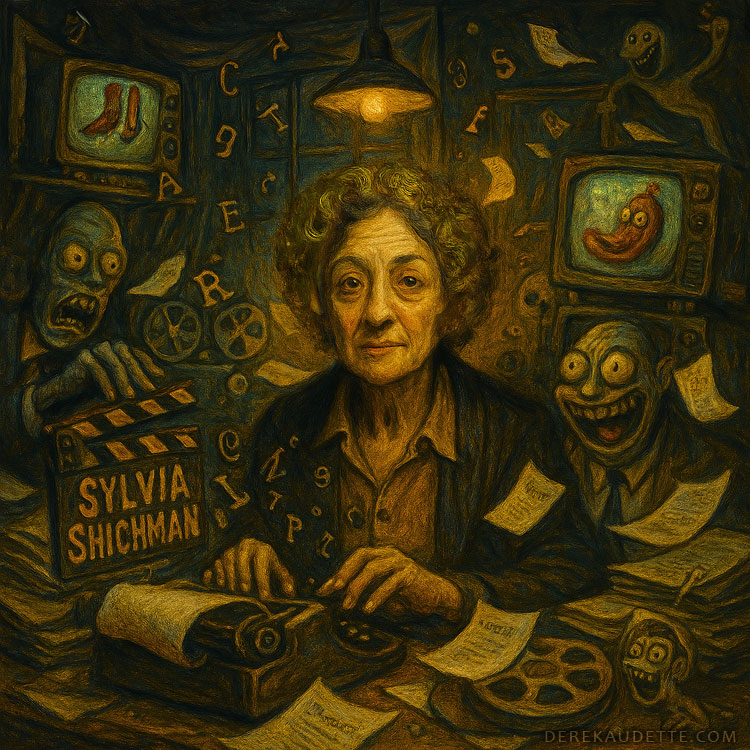In the annals of television history there are names that echo through the corridors of time, their contributions immortalized in the chronicles of pop culture. Then, there are names like Sylvia Shichman — a footnote, a whisper, a fleeting moment in the grand tapestry of entertainment. Yet, within that fleeting moment lies a story of absurdity, influence, and the kind of offbeat brilliance that only the truly unconventional can appreciate.
Eight years ago I wrote a short blog post here entitled “The Internet Needs More Sylvia Shichman“. Eight years have passed and a recent search has revealed to me that not much has changed in that regard. The internet, today, remains woefully bereft of Sylvia Shichman related content — yet the need for more, in my most humble opinion, is still just as pressing as it ever was.
Since it seems that, in all that time, no one read my original post and then took it upon themselves to remedy the state of sorrowful lacking that our information super-highway is currently existing within with regards to the presence of Ms. Schichman related content, I figured that I had better just apply a little bit of elbow grease and go ahead and do it myself. And so, my friends, for your reading pleasure, I bring you: The Unlikely Odyssey of Sylvia Shichman:
Origins in Chaos – The Early Life of Sylvia Shichman
Sylvia Shichman was born on May 15, 1905 (The very same day that Las Vegas, Nevada was officially founded no less), in a place that sounds like a fever dream: Ghyash, Romania — now Moldova, if you want to get pedantic. Its the kind of village that might vanish from a map but will nevertheless leave a permanent imprint on your DNA. Picture narrow streets slick with mud, chickens running like anarchists seeking election to powerful political positions, and a sky that seldom bothers itself with the concept of “blue.” Into this chaos came Sylvia, already equipped with the uncanny ability to notice the absurd, the grotesque, and the deeply ridiculous in everyday life.
Her family, like many East European families of the early 20th century, decided that the old continent had had just about enough of them, and so they packed up their possessions and moved to another continent — one which had proven itself as being much better than Europe in the field of including within itself the United States of America. They landed somewhere along the Eastern seaboard — Bridgeport, Connecticut, to be precise — a place with factories coughing smoke like dying dragons with a pack-a-day tobacco habit, and people so busy trying to survive that they barely ever noticed Sylvia sketching the world around them in the margins of their Qui Transtulit Sustinet stained lives.
As a child, Sylvia learned early that normalcy is a lie perpetuated by those too lazy to look deeper into the fuming potholes of existence. She walked streets of endless brick and soot, observing humanity in its purest, most ludicrous form. Somewhere between the smell of wet coal and the howl of train whistles at 3 a.m., she absorbed a sense of the absurd that would later define her work. School was a circus, teachers were cardboard cutouts, and playgrounds were arenas for human folly and unspeakable acts of childhood drama. She thrived not in conformity but in watching the chaos, cataloging it, and occasionally poking fun at it whenever the adults weren’t looking.
It’s tempting to imagine Sylvia as a quiet, mysterious figure, but she had a spark of mischief. She knew that life was simultaneously hilarious and horrifying, and that you could survive only by either laughing at it or becoming part of its maliferous spectacle.
Sylvia Shichman’s Career & Mr. Mike’s Mondo Video
By the late 1970s, television had become a battlefield of mediocrity and canned laughs, and Michael O’Donoghue — the king of mischief formerly of Saturday Night Live — was assembling a war machine disguised as a TV special. Somehow, into this madness stepped Sylvia Shichman, a figure enigmatic enough to inspire curiosity, if not outright speculation. She was part of the eclectic writing team that birthed Mr. Mike’s Mondo Video, a kaleidoscopic assault on the senses, satire, and any passing notion of polite decorum.
Mondo Video wasn’t merely a show; it was a fever dream of sorts. A montage of grotesque sketches, bizarre vignettes, and satirical punch-ins to the gut of society’s absurd corporeal essence. It was the TV equivalent of a lunatic running through Times Square in a tutu, waving a Hello Kitty™ branded chainsaw. Within this chaos, Sylvia Shichman’s fingerprints were subtle but undeniable — she contributed to the segments that made the show simultaneously absurd, provocative, and impossibly funny. Her writing helped push boundaries, challenging audiences to confront the gross inanity of media, celebrity, and human behavior.
The special had initially been slated for network television but later deemed too radical for prime-time sensibilities. NBC, ever cautious, balked. O’Donoghue shrugged, slapped on a metaphorical leather jacket (one size too big), and decided to release it theatrically. Critics were confused, audiences were bemused, and somewhere in the middle of it all, Shichman’s work found its home — a cult-classic testament to creative audacity. Or, as Mr. Mike himself would say: “Violent absurdity.”
Watching Mondo Video is like staring at a Salvador Dalí painting while riding a roller coaster — you’re disoriented, challenged, and occasionally doubled over in laughter — you don’t really know exactly what it is you’re looking at, but you’re certainly never bored. There are surreal interludes, grotesque exaggerations, and bizarre cultural commentary woven into each segment. It’s the kind of art where the more you squint, the more you see, and Shichman’s contribution adds layers to that vision — subtle, yet piercing.
Her work in Mondo Video exemplifies a rare quality: the ability to recognize the exquisitely bizarre fatuity of human nature without in the least bit patronizing it. She understood that satire is not just laughter at others but a mirror held up to society’s collective face, reflecting its weirdness in ways that are simultaneously funny and unsettling. The humor is not gentle; it’s a slap of reality coated in irony, and Shichman’s touch helped shape that tone.
The Artistic Philosophy & Style of Sylvia Shichman
Sylvia Shichman’s genius — if you can call it that without sounding pretentious — lay not in the overtly flashy, nor in the mainstream, but in the quiet precision with which she wielded absurdity like a scalpel. In Mr. Mike’s Mondo Video, she demonstrated an instinct for the bizarre, the uncanny, and the ridiculous, crafting moments that made the audience squirm, laugh, or recoil — often all at once.
Shichman understood the value of contrast. In a world full of polished, formulaic television, her work thrived on the unexpected, the uncomfortable, the grotesque. A man with webbed toes might appear for thirty seconds on screen, only to be followed by a surrealist sketch that defies categorization entirely — she was a part of the whole collage of that, and she fit right in. She knew that the audience’s mind must be constantly jolted, disoriented, and made to reconsider the ordinary.
Shichman didn’t sugarcoat the absurdity of life; she embraced it, dissected it, and laid it bare. Her work conveyed the kind of truth that’s messy, awkward, and often hilarious but also often poignant and truthful — the reality that many people try hard to avoid looking at too closely. Life, after all, is a series of strange coincidences and banal horrors — some meaningful and some meaningless, and her writing mirrored that with fine precision.
In her segments, satire wasn’t just a tool — it was a philosophy. The content was never mean-spirited; rather, it contained incisive observations, delivered with wit sharp enough to cut through the pretense of normality. Mondo Video became a laboratory where Shichman and her collaborators could experiment with absurdity, stretching it to its limits and letting it explode into the audience’s consciousness.
It’s tempting to over-intellectualize her style, to categorize it as “avant-garde” or “postmodern satire,” but that would miss the point. Her brilliance was in making the audience feel the chaos, the absurdity, the sheer unpredictability of human behavior — not as an academic exercise, but as a living, breathing, sometimes vomit-inducing reality. And that, in the end, is what makes her work so memorable: it sticks in your brain like a bad dream that’s also somehow pretty damned hilarious.
Legacy & Influence
Sylvia Shichman’s legacy is the kind of thing you can’t measure in ratings, awards, or polite applause. It’s the residue she left behind in the flickering cathode glow of an old television set that never quite obeyed the rules. Mr. Mike’s Mondo Video was a carnival ride careening through the American subconscious, and she was one of the conductors steering it through the chaos with a grin that said, “Hold on tight — we’re in for one hell of a weird ride.”
Watching her work today is like stumbling into a fever dream in the wee small hours of the morning, naked and slightly terrified, while someone hands you a pencil and paper and whispers, “You’d better take notes, you’ll want to have a record of this.” That’s the Shichman touch: the punchline comes not just from the joke itself but from the cosmic chaos surrounding it, the small acts of subversion tucked between the camera cuts, the strange logic that says, “Yes, a man can worship Jack Lord and yes, the world will clap along, laughing all the way.”
Her influence isn’t on the charts. You won’t see it listed on Wikipedia as a bullet point, and that’s exactly how she would have wanted it, I suspect. The true mark of her genius is the ripple effect: the writers who came after, the comedians who learned that television doesn’t have to be safe, and the cult audience that still chuckles in darkened rooms at the memory of a man with webbed toes or a church devoted to TV icons with bitchin’ hair. She taught them all that absurdity isn’t just entertainment — it’s a lens, a weapon, a survival mechanism.
In the world of comedy, the measured, safe, and polished is often rewarded. But Shichman lived in the margins — in the corners where things get weird, uncomfortable, and just a little dangerous. She understood that the real work of art isn’t in pleasing the audience but in dragging them through the muck, showing them the teeth beneath the smiles, and leaving them breathless, laughing, and slightly unnerved.
The cult status of Mondo Video isn’t accidental. It’s the result of a perfect storm of writers, performers, and anarchic energy — a storm that Shichman was in the eye of…. or, maybe the outskirts of. I’m not sure. But, even decades later, her fingerprints remain in the DNA of dark, satirical television, in the offbeat sketches that make you question what’s funny and what’s real. She was a quiet architect of chaos, and that chaos has a long half-life.
In the end, Sylvia Shichman didn’t need accolades. She didn’t need fame. She needed the absurdity, and the absurdity needed her. And if you’re paying attention — really paying attention — you can still see her influence in the strange, the hilarious, the cheap thrills, the pointless perversities, the shabby secrets, the grotesque, the pathetic, unholy… uh… the unholy, the twisted, the macabre, the outré, the eerie… uh… the mystifying, the sky above, the mud below, blue water, white death, the search for Michael Rockefeller and most, if not all, of the slightly horrifying corners of comedy today. She was an insouciant conductor in a symphony of madness. And the world, it seems, was just smart enough to survive the ride.
Closing Time
Sylvia Shichman’s story is not the kind of tale you tell at dinner parties, unless your guests are already half-catatonic from life’s relentless barrage of strangled aberrancy. No, this is a story that drags you down alleyways of television history and says, “Welcome to the circus, Kido. Nothing really makes very much sense, and that’s kind of the point. You’ll get it eventually.”
Her work, stitched into the patchwork nightmare that was Mr. Mike’s Mondo Video, survives because she treated reality like a cocktail glass — shake it, slam it, and watch the pieces scatter across the floor. There was a pulse to it: wild, dangerous, unpredictable. But there was a truth to it as well: the world is ugly, the human condition is absurd, and the only way to survive is to laugh and keep scribbling, even if you know no one will ever read those scribbles.
She moved through the chaos of her time like a ghost with a typewriter strapped to her chest, feverishly punching out words while the world insisted on normality. And isn’t that the beauty of it? The newspapers ignored her, the critics — if they had ever even heard of her — scratched their heads. And somewhere out there, in a dimly lit editing room, Shichman laughed — not quietly, not politely, but with a sound that scraped the paint off the walls. She seemed to understand that life is mostly messy, mostly unfair, and mostly hilarious if you’re willing to stare it dead in the eye.
So, rest in peace Ms. Shichman. You passed from this world on March 21, 2002 in Pembroke Pines, Florida — and when you went the world got a little less weird and a little less wonderful because of your departure. But some of us will remember you — or, at least, something of you — a glimpse, a whisper, a shadow, or merely a symbol perhaps… but something.
Somewhere in the theater of forgotten television, her voice still echoes — a flicker in the dark, a smirk in the static. She was never about fame. She was about witnessing life in all of its grotesque, absurd glory and then reflecting it back to the world with surgical irreverence. And maybe that should be damned well good enough for just about anybody.
We don’t remember Sylvia Shichman because she wanted us to remember her. We remember her because she dared to look at the world and say, “This is ridiculous, this is painful, and this — this right here — this is funny as hell, even if you don’t get it.” That’s a rare gift, and a dangerous one, because once you’ve seen it, you can’t unsee it — that bell wont be unrung. And that, dear reader, is exactly why the ghosts of her work still linger in the corners of television comedy to this day — half forgotten, half celebrated, and wholly alive in the minds of those willing to ride the wave of absurdity she left behind.
And maybe, just maybe, all of the above — the entirety of all you’ve just read here — is true. Or, maybe none of it is — or at least very little. Maybe, as it turns out, there really is, still, precious little information about Sylvia Shichman out there that I could find. And so, in wanting to grace the internet with more Sylvia Schichman — as per its very pressing need that was noted in my earlier article — I just made all of that shit up for the sake of piss and pomegranates. Perhaps I just got bored and felt like writing something. …Perhaps. So, read the disclaimer carefully, my friend. Nothing is real; everything is permitted. You’ve been promised nothing.
Further Reading:
- Mr. Mike’s Mondo Video (Wikipedia) – Background on the 1979 satirical television special created by Michael O’Donoghue.
- Michael O’Donoghue (Wikipedia) – Learn more about the “dark prince” of Saturday Night Live and his groundbreaking satire.
- A Word on the Phenomenon of Cult Classics – From TV Tropes.













